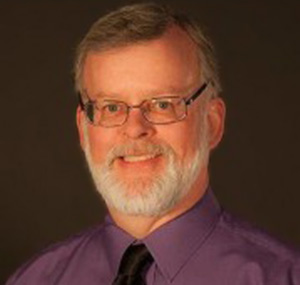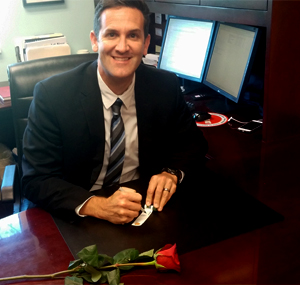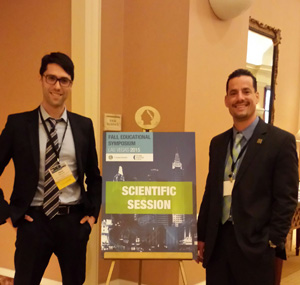M
Leave a Legacy of Giving
You can support our mission of changing lives by saving sight in multiple ways!

 As a manager, husband, father and grandfather, Steve was missing out on seeing many things in life. As his vision worsened, he thought he might need a stronger prescription. When Steve went to the eye doctor in 2012, they determined he had an eye condition called Fuchs’ corneal dystrophy.
As a manager, husband, father and grandfather, Steve was missing out on seeing many things in life. As his vision worsened, he thought he might need a stronger prescription. When Steve went to the eye doctor in 2012, they determined he had an eye condition called Fuchs’ corneal dystrophy.
“When my doctor told me I had Fuchs’ I didn’t know much about it and went back home to read up on it,” said Steve. Fuchs’ corneal dystrophy is a hereditary eye disease that causes vision to worsen as an inner layer of the cornea deteriorates. If left untreated, one can lose sight in that eye.
Over a 5 year period, Steve’s eyesight declined, causing him to lose the ability to read normal print. Driving at night also became a challenge for him. “I had lost a lot of that visual acuity,” said Steve.
As an office manager, Steve’s work requires a lot of reading and time on the computer. The decision was made for Steve to have a corneal transplant in 2015. “I thought it important to go ahead with surgery and thought it was important to do it to keep my level of performance at my job. It made a big difference,” said Steve.
Because of the generous decision and gift of corneal tissue from a donor and their family, Steve can now continue to work the next several years until retirement. Steve chose to write to his donor family through Saving Sight’s correspondence program to thank them. “I know that there are a lot of generous people out there and that’s one side of that – that someone made that decision – I wanted to let their family know how much I appreciated it,” said Steve.
Prior to his transplant, Steve did not have a connection to donation or know much about the transplantation process, though he has been a blood and platelet donor in the past. Steve said during the process there was a lot to learn about the eyes and the impact of what it means to go through the surgery and the healing process.
“From my first diagnosis, to the surgery, to the healing process – that whole process takes a while – but it’s an interesting adventure to see yourself healing,” said Steve.
His transplant and recovery were a success. And Steve said that the generous gift of sight has improved his quality of life immensely. “It gives me more enjoyment – brighter colors and clarity – there were things I was missing that I didn’t even know I was missing.”
To join the millions of Americans who have signed up for the donor registry, register online at Donate Life America or at your local Department of Motor Vehicles office. And be sure to share your decision with your family and friends.
 For many, the New Year means new resolutions. Some resolve to spend more time with family, while some resolve to live healthier. Others might resolve to make a difference in 2016. At Saving Sight, we change lives every day. It’s easy for you to join us in our mission to save sight and make a difference this year in the lives of
For many, the New Year means new resolutions. Some resolve to spend more time with family, while some resolve to live healthier. Others might resolve to make a difference in 2016. At Saving Sight, we change lives every day. It’s easy for you to join us in our mission to save sight and make a difference this year in the lives of
those we serve.
Saving Sight helped bring the gift of sight to more than 7 people everyday in 2015 by coordinating eye donation in Missouri, Kansas and central Illinois. You can enhance and save more than 50 lives simply by joining the eye, organ, and tissue donor registry today. Become a registered donor at registerme.org.


Kelly Odell of Lions VisionGift in Portland, Oregon is the 2016 recipient of the Jachin Misko Memorial Scholarship for Technical Advancement in Eye Banking.
The Eye Bank Association of America (EBAA) and Saving Sight awarded the 2016 Jachin Misko Memorial Scholarship for Technical Advancement in Eyebanking to Kelly Odell, a processing technician at Lions VisionGift in Oregon. The scholarship will support Odell’s attendance at the EBAA’s Technician Education Seminar January 20-23 in Tampa, Florida.
The Misko memorial scholarship honors the memory of Jachin Misko who was a leader in eye banking at Saving Sight. Misko was instrumental in Saving Sight’s establishment of a DSAEK cutting lab and served on several national committees with the EBAA. The sholarship has honored his legacy over the last three years by helping send a promising eye bank technician to EBAA’s annual Technician Education Seminar.
“This scholarship is a particularly meaningful way to honor Jachin because it represents the impact he had on all of us and on changing lives by saving sight through eye banking,” said Saving Sight CEO Tony Bavuso.
Odell has been a member of the Lions VisionGift team since March 2014. Since that time, she’s transitioned from a per diem recovery technician to full-time recovery technician and then from a processing technician I to her current position as a processing technician II. She says seeing the impact her work has on others is the most rewarding part of what she does.
“We can be pretty far removed from the process,” Odell said, “So getting notes back from donor families and donor recipients really puts what we do into perspective. Knowing how meaningful transplanted corneas and tissue can be to the families who benefit, it’s rewarding to be a part of that.”
The Jachin Misko Memorial Scholarship for Technical Advancement in Eye Banking is made possible by Saving Sight and Numedis, a producer of corneal preservation media.
“It’s a pretty amazing opportunity that Saving Sight and Numedis provides to help eye bank technicians who might not otherwise get to attend the Technician Education Seminar to learn more about the practice of eyebanking,” Odell said. “I’m extremely honored to receive the scholarship.”


Dolan Dalpoas, President of Abraham
Lincoln Memorial Hospital in Lincoln,
Illinois, signs a rose vial in honor of eye
donors from the hospital.
On January 1 each year, millions from around the world ring in the New Year by tuning in to watch the annual Tournament of Roses Parade broadcast from Pasadena, California. Floats featured in the parade are covered completely with natural materials, each containing more flowers than the average florist will use in five years. While every float is adorned with beautiful flowers, the roses of one float are unique.
Since 2004, Donate Life America has used the global platform the Rose Parade provides to share the life changing power of organ, eye and tissue donation with the world. A special rose dedication garden on the float honors the legacy of donors and the partners who help make organ, eye and tissue donation possible. Saving Sight is working with partner hospitals across its service region to honor the more than 1,600 eye donors who have given the gift of sight through eye donation in 2015 by dedicating roses in their honor on the 2016 Donate Life Rose Parade float.
“It’s an incredible gift these donors make through eye donation. They forever change the lives of corneal transplant recipients,” said Saving Sight Chief Executive Officer Tony Bavuso. “We’re excited to work with local hospitals to honor that gift by dedicating roses that will be seen around the world as part of the 13 Donate Life Rose Parade float.”
Saving Sight has coordinated rose vial signings at partner hospitals across Missouri, Kansas, and central Illinois, inviting hospital executives to sign a vial with a message honoring eye donors from the hospital. The message, and a rose dedicated by Saving Sight for those donors, will ride aboard the Donate Life Rose Parade float, “Treasure Life’s Journey,” on January 1.
You can save up to eight lives through organ donation and enhance the lives of up to 50 more as an organ, eye and tissue donor. Join the more than 120 million Americans who have registered change lives as a donor. Visit registerme.org to sign up for the organ, eye and tissue donor registry today.


Gabriel Rand (left) and Patrick Gore (right) at the Cornea Society and Eye Bank Association of America’s Fall Educational Symposium.
New research could help Saving Sight and other eye banks more easily identify donated tissue which may be better suited for research than transplantation simply by examining donor medical records. A recent study of 12,703 cornea donors found use of certain topical glaucoma medications was associated with lower corneal endothelial cell density of donors. Cell density is an important factor in determining the best use of donated eye tissue.
By using this information to evaluate potential eye donor cases, Saving Sight and other eye banks could focus on recovering tissue for transplant which provide the best chance for successful transplants. Other tissue could be recovered specifically for research purposes to help save sight through advances in medical practice.
Saving Sight Senior Director of Business Development Patrick Gore, RN contributed to the research as a co-author. Gore said this research is exciting because it demonstrates how eye banks can leverage data to make decisions.
“This is the tip of the iceberg in terms of how eye banks can leverage donor information to make data-driven decisions and be the best stewards possible of the precious gift of sight donors give through eye and tissue donation,” Gore said.
The findings were presented at the Cornea Society and Eye Bank Association of America’s Fall Educational Symposium in Las Vegas, Nevada on November 13, 2015 by Gabriel Rand, MA. In addition to Gore and Rand, tthe study was also coauthored by Ji Won Kwon, MD, PhD; Kyong Jin Cho, MD, PhD; Mitchell D. McCartney, PhD; and Roy S. Chuck, MD, PhD.